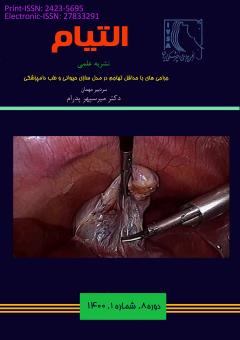القای پریتونیت عفونی با روش لیگاتور کردن سکوم و سوراخ کردن آن با الکتروکوتر به کمک لاپاروسکوپی در مدل حیوانی خرگوش
محورهای موضوعی : علوم جراحی دامپزشکی شامل جراحی های بافت های سخت و نرممهدیه کاتبیان 1 , میر سپهر پدرام 2 , مجید مسعودی فرد 3 , مهدی نصیری 4
1 - دانشجو، گروه جراحی و تصویربرداری تشخیصی، دانشکده دامپزشکی، دانشگاه تهران، تهران
2 - استادیار، گروه جراحی و تصویربرداری تشخیصی، دانشکده دامپزشکی، دانشگاه تهران، تهران
3 - دانشیار، گروه جراحی و تصویربرداری تشخیصی، دانشکده دامپزشکی، دانشگاه تهران، تهران
4 - دانشیار، گروه جراحی و تصویربرداری تشخیصی، دانشکده دامپزشکی، دانشگاه تهران، تهران
کلید واژه: سپسیس, پریتونیت عفونی, مدل حیوانی خرگوش, CLC,
چکیده مقاله :
سپسیس یک سندرم است و درنتیجه پاسخ شدید بدن میزبان به تهاجم میکروارگانیسمهای پاتوژن یا توکسینها میباشد. علیرغم استفاده از آنتیبیوتیکها، مداخلات جراحی و مایع درمانی، همچنان سپسیس به عنوان یک عامل مرگومیر مهم در مراکز درمانی مطرح میباشد. برای شناخت این سندرم، چندین مدل تجربی ازجمله، تجویز لیپوساکاریدها، پریتونیت بدنبال کارگزاری استنت در کولون صعودی، لیگاتور سکوم و سوراخ کردن آن و وارد کردن پاتوژنهای باکتریایی به داخل محوطه بطنی، معرفی شده است. در این مطالعه از 8 خرگوش بالغ نر سفید نژاد نیوزیلند استفاده شده است. در گروه کنترل ( 4 خرگوش) لاپاروسکوپی اکتشافی انجام شده است، سکوم از قسمت پایین دریچه ایلئوسکال و با استفاده از یک پنس آتروماتیک از محل ورود تروکار بیرون کشیده شده است. سپس سکوم به شکم برگردانده شده و شکم به طور مرسوم بسته شده است. در گروه آزمایش ( 4 خرگوش): بعد از لاپاروسکوپی اکتشافی، سکوم لیگاتور شده و با استفاده از کوتر تکقطبی، سکوم از سطح آنتیمزانتریک تا مزانتریک سوزانده شده است. سپس سکوم به داخل شکم برگردانده شده و شکم به طور مرسوم بسته شده است. قبل و 24 ساعت بعد از جراحی، ضربان قلب، دمای مقعدی و تعداد تنفس خرگوشها اندازهگیری شده است. 24 ساعت بعد از جراحی، سونوگرافی از محوطه بطنی انجام شده است. بعد از 24 ساعت،CBC و کشت از مایع بطنی گرفته شده است. آنالیز استاتیک افزایش معنیدار فند خون را در گروه آزمایش به نسبت گروه کنترل را نشان میدهد. علاوه براین نتایج کشت مایع بطنی در تمام خرگوشهای گروه آزمایش مثبت بوده است.
Sepsis is a complex and dynamic syndrome and it is a medical and economic challenge. To learn more about pathophysiology of this syndrome, animal models have been introduced. Poly microbial sepsis induced by cecal ligation and puncture is the gold standard model of this condition. The purpose of this study was introducing a new method of septic peritonitis with laparoscopic assisted cecal ligation and cauterization (CLC) in rabbit model. This study included two groups of adult male New Zealand white rabbits: Control group (4rabbits): exploratory laparoscopy was performed and the cecum was grasped from the distal of ileocecal valve using an atraumatic forceps and pulled out from the trocar entry site. CLC group (4 rabbits): the cecum was ligated and two sites of cecum were cauterized from antimesenteric to mesenteric surface of cecum. Before and during 24 hours after the operation, heart rate, rectal temperature and respiratory rate of rabbits were monitored. Ultrasonography, CBC, peritoneal fluid analysis and bacterial culture was checked 24 hours after the surgery. Statistical analysis of the data in CLC group rabbits showed a significant increase in heart rate 6 and 18 hours after surgery (tachycardia) and increase in respiratory rate from 6 to 24 hours after surgery (tachypnea). In addition, a significant decrease in glucose of serum was observed. Bacterial culture was positive and peritoneal analysis of all rabbits in CLC group indicated the presence of bacteria and infection.
polymicrobial sepsis? Trends in Microbiology, 19(4), 198–208.
2. Song, T., Yin, H., Chen, J., Huang, L., Jiang, J., He, T., … Hu, X. (2016). Survival advantage depends on cecal volume rather than cecal length in a mouse model of cecal ligation and puncture. Journal of Surgical Research, 203(2), 476–482
3. Menezes, G. B., Amaral, S. S., Alvarenga, D. M., & Cara, D. C. (2008). Surgical procedures to an experimental polymicrobial sepsis : Cecal Ligation and Puncture. Brazilian Journal of Veterinary Pathology, 1(2), 77-80
4. Weisse, C. Mayhew, P. Equipment for Minimally Invasive Surgery. In K.M. Tobias & Johnston (Edt). VETERINARY SURGERY: SMALL ANIMAL (vol 53, pp291)
5. Sackman, jill. (2012). Surgical Modalities: Laser, Radiofrequency, Ultrasonic, and Electrosurgery. In K. m. Tobias & Johnson (Eds.), VETERINARY SURGERY: SMALL ANIMAL (vol 53, pp. 180-183 )
6. Bicalho, P. R., Lima, L. B., Alvarenga, D. G., Duval-Araujo, I., Nunes, T. A., & Dos Reis, F. A. (2008). Clinical and histological responses to laparoscopically-induced peritonitis in rats. Acta Cir Bras, 23(5), 456–461
7. Kingsley, S. M. K., & Bhat, B. V. (2016). Differential Paradigms in Animal Models of Sepsis. Current Infectious Disease Reports.18(9)
8. Hubbard, W. J., Choudhry, M., Schwacha, M. G., & Kerby, J. D. (2005). Cecal Ligation and Puncture: Shock. Shock (Augusta, Ga)
9. Popov, D., & Pavlov, G. (2013). Sepsis Models in Experimental Animals. Trakia Journal of Sciences, 11(1), 13–23.
10. Maier, S., Traeger, T., Entleutner, M., Westerholt, A., Kleist, B., H??ser, N., … Heidecke, C.-D. (2004). CECAL LIGATION AND PUNCTURE VERSUS COLON ASCENDENS STENT PERITONITIS: TWO DISTINCT ANIMAL MODELS FOR POLYMICROBIAL SEPSIS. Shock, 21(6), 505–512
11. Meisel, C., Schefold, J. C., Pschowski, R., Baumann, T., Hetzger, K., Gregor, J., … Volk, H. D. (2009). Granulocyte-macrophage colony-stimulating factor to reverse sepsis-associated immunosuppression: A double-blind, randomized, placebo-controlled multicenter trial. American Journal of Respiratory and Critical Care Medicine, 180(7), 640–648.Berguer, R., Alarcon, a, Feng, S., & Gutt, C. (1997). Laparoscopic cecal ligation and puncture in the rat. Surgical technique and preliminary results. Surgical Endoscopy, 11(12), 1206–1208.
12. Berguer, R., Alarcon, a, Feng, S., & Gutt, C. (1997). Laparoscopic cecal ligation and puncture in the rat. Surgical technique and preliminary results. Surgical Endoscopy, 11(12), 1206–1208. http://doi.org/10.1007/s004649900570


